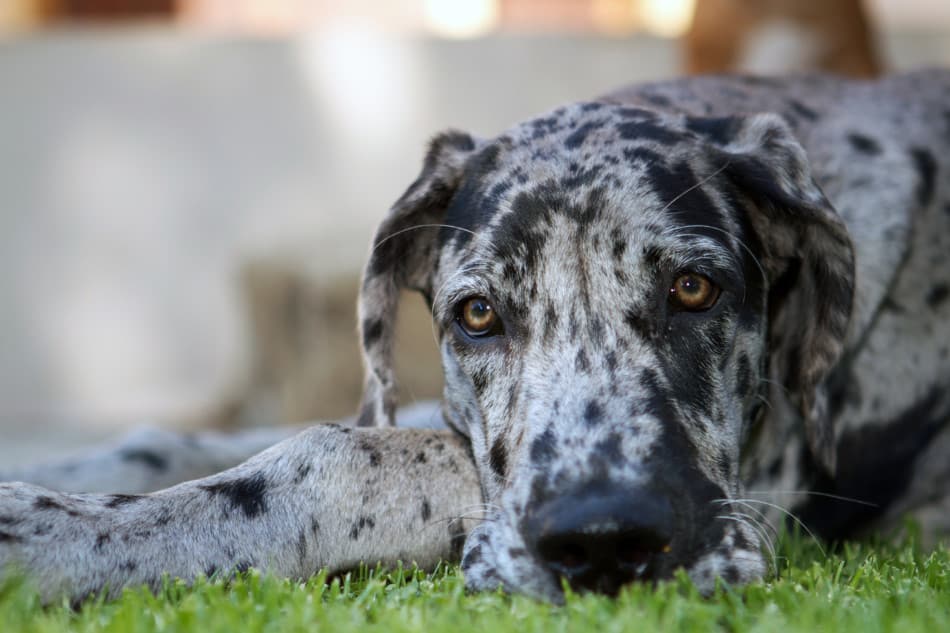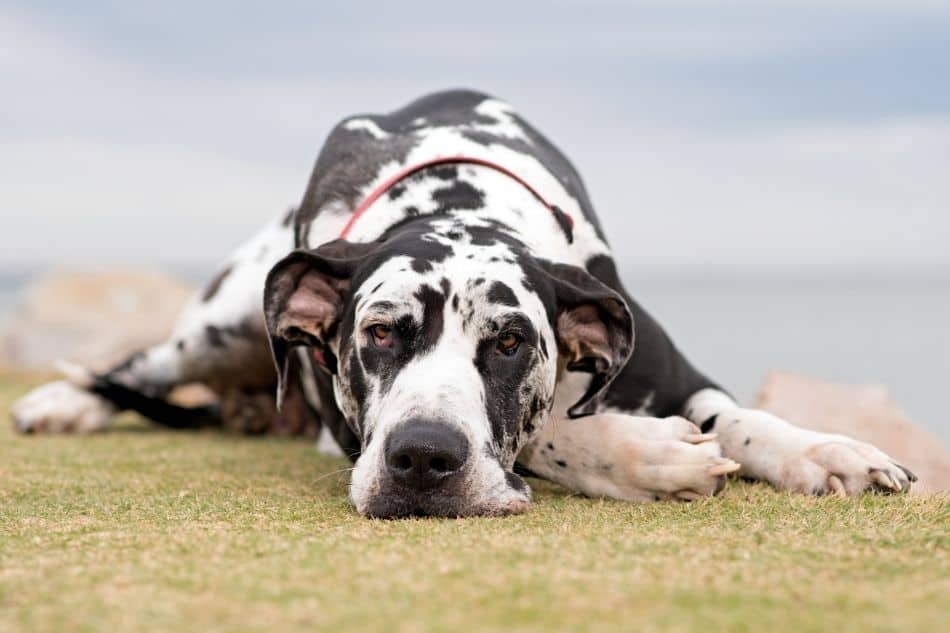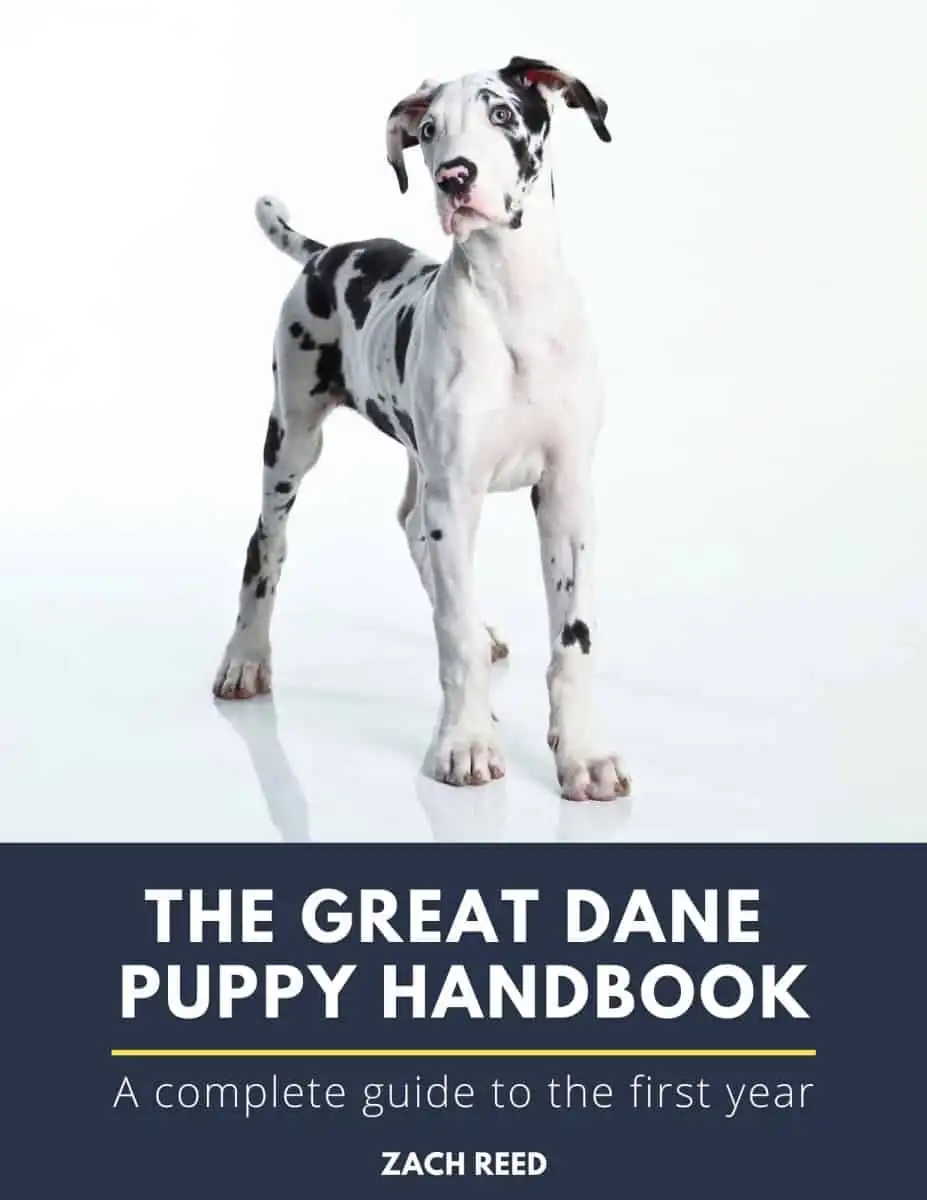
As with many dogs, Great Danes come in a variety of different colors! Fawn, Brindle, Black, Harlequin, Mantle, Blue, and Merle are the seven standard colors recognized by the Great Dane Club of America. These colors are considered show-acceptable. However, you can still register your Merle Great Dane as a pure breed with the American Kennel Club.
Merle Great Danes are beautiful animals. They are identified by their unique coat pattern. Merles usually have a lighter coat with darker grey spots or splotches all over.
Merle coats are common in more breeds than just Great Danes. It can also be seen in Australian Shepherds, Shetland Sheepdogs, Welsh Corgis, American Bullys, and many more!
Even with the distinctive coat pattern, there are also a variety of Merle coloring options. They can have a combination of grey, blue, white, or black coats and markings.
Although, a grey color, in the base coat or spots, it is the standard marking of a Merle Great Dane.


Sometimes Merle Great Danes are confused with Harlequin Great Danes. Harlequins typically have a white base coat with black spots.
Merles, on the other hand, typically have a grey base coat. Merles are often produced from Harlequin litters.
How do Merle Great Danes Occur?
Merle Great Danes are often produced while breeding Harlequin Great Danes. The only genetic difference between the two is the gene that creates the grey coloring in Merles.
While breeding two Harlequin Great Danes, litters will typically have one or two Merle puppies. The same can be expected when breeding a Harlequin and a Mantle Great Dane. However, the latter is the preferred breeding method.
Having a Merle Great Dane is dependent on having the Merle gene, which is responsible for the grey base coat. When a pup has two merle genes, they will likely be White Danes (more information about White Great Danes in our article here).
These types of dogs are more likely to experience health problems. This typically happens when two dogs with the merle-gene are bred, like two Harlequins.
Historically speaking, breeders at one point tried to eliminate the Merle coloring. They tried to do this by being selective in their breeding choices. However, this was not successful, as we still have Merle Great Danes today. Lucky us!
For a simple guide on how to best care for your Great Dane, please make sure to take a look at my book “The Great Dane Puppy Handbook“.
The Great Dane Puppy Handbook takes all of the need-to-know Great Dane info and packages it together into a single, concise resource. Save yourself time, money, and frustration by avoiding the most common mistakes made by Great Dane owners!
Are Merle Great Dane’s Rare?
Some breeders will try to sell Merle Great Danes at a more expensive price, claiming they are a rarer coloring. However, because you can typically find at least one in a litter, you should not necessarily be paying more for a Merle pup.
Merles can also sometimes be mistaken for Harlequins depending on their color variation.
However, some Merles may be rarer depending on their coloring. Merles with blue or even tan/brown coloring are slightly less common than those with the standard grey, white, and black markings.
If you’re looking for a reputable breeder to work with, make sure to take a look at our list of Great Dane breeders here.
Variations of Merle Great Danes
As previously mentioned, Merle Great Danes do come in different color varieties. The grey base coat with irregular black spots and splotches seems to be the standard coloring.
They may have white patches on their chest and feet. While not an exhaustive list, other types of Merles are described below.
Merlequins may initially look like Harlequin Great Danes. They will likely have a white base coat, with irregular merle or grey spots and splotches. These are sometimes mistaken as Harlequins, depending on the color variation.
Brindle Merles have a more distinct pattern, as it is a combination of the traditional Brindle and Merle pattern. The Brindle pattern is marked by multi-colored stripes.
The stripes are usually a combination of black, brown, gray, and red. A Brindle Merle has a more muddled coat. You can see stripes and spots of all colors, depending on the specific dog.
Mantle Merles typically have a white base coat, similar to Mantle Great Danes. Mantle Great Danes have black spots. The Mantle Merles, on the other hand, will have silver or grey spots all over.
Blue Merles have a light grey base coat. However, the base coat can sometimes be described as silver as well. Their irregular spots and splotches are blue. Blue Merles may also have blue noses.
Fawn Merles tend to have tan or brown coloring with merle or grey spots all over. These are not to be confused with Fawn Harlequins, which have a white base coat with tan spots.
Chocolate Merles are similar to Fawn Merles as they have a tan/brown coat. However, they have chocolate or red irregular spots all over.
Finally, White Great Danes are produced when the dog has two merle genes, one from each parent. They are typically all white with very few markings.
Their nose, ears, and the area surrounding their eyes may have more red or pink undertones. This is the rarest coloring for a Great Dane.
Merle Great Dane Health Issues
As a larger breed, Great Danes are already at a higher risk of having health-related issues. Merle Great Danes are no exception. Thankfully, Merle Great Danes can be perfectly helpful.
Typical health issues for any Great Dane include heart disease, cancer, foot and pad issues, Wobbler’s Syndrome, hip dysplasia, and hypothyroidism. These are all typical health concerns in larger breeds.
The specific issues for Merle Great Danes come when two dogs carrying the Merle gene are bred and produce a litter. Blindness and deafness are two common health issues seen in Merle Great Danes.
They are also particularly seen in White Great Danes. These same issues are also seen in other breeds like Collies and Aussies.
Merle Great Dane Breeding Issues
Breeding Merle Great Danes is considered unethical by the Great Dane Club of America’s Breeder’s Code of Ethics and should not be done intentionally.
While they are beautiful dogs, breeding Merles can result in stillborn or sick puppies, blindness, and deafness. These puppies will also have a higher risk of having health issues later in life.
These health issues are typically seen in White Great Danes, the product of two Merles breeding. Deafness and blindness are common occurrences. They may also suffer from a condition where their eyes are physically smaller than they should be.
However, not all White Great Danes are automatically deaf and blind. Once they are old enough, they should be tested to confirm any issues.
Should you have a deaf and/or blind, this should not be cause for concern. With patience and a bit of training, you should have a well-behaved pup with a good quality of life.
And thankfully, blindness and deafness are rarely passed on, should you choose to breed your White Great Dane. However, this is still strongly recommended against doing so.
Other issues may include aggressive behavior, skin disorders, and brain abnormalities. However, more research is needed to definitively conclude these are products of the double merle-gene.
Ultimately, if you have a Merle Great Dane, it is recommended to have them neutered or spayed. However, if you are interested in breeding and you are worried about your Great Dane having the merle-gene, there are now dog DNA tests available for purchase.
Not all commercial tests specifically look for the merle-gene, so be sure to research the product before purchasing.
We hope that you found this information helpful. Before you go, make sure to take a look at our favorite products for Great Danes!
Pro Tip: If you’re looking for a resource that guides you through everything from A-Z about raising a Great Dane then you should absolutely take a look at the Great Dane Puppy Handbook. It’s everything that a busy owner needs to feel calm and confident about raising their dog.



How does a dog get the Merle gene? Is it a case of inbreeding?
Merle is one of eight naturally occurring genes responsible for the color of a dog’s coat. Aside from a random mutation, the merle gene is passed to a puppy from its parents.
Thank you for all the information on Merle Danes. We lost our Mantle Dane …. Skykar ….. to bone cancer
We still have our Blue…. Jazzmin
Strongly considering a Merle puppy
Sure want to avoid health issues
That bone cancer was a
Horrible experience. Thank you
I had a gorgeous blonde merle Great Dane many yrs ago. Never seen another one w her coloring. Mom was fawn and dad was what they called a blonde fawn although he looked regular to me. My Mandy’s base coat was beige w pale grey spots a little white on her chest. Her eyes were beautiful, almost the same color. Loved her floppy ears. She was small 110 lbs fully grown but I like smaller Danes they’re not so inbred and dopey. She was a real feminine lady who loved her couch and my bed. She lived to 11. She got Lymes disease but seemed to be ok after treatment. I had her for 11 yrs she was my sweet baby. I’d love another one. Don’t care for most breeders or AKC. She was a special girl.
Probably should update the website due to the fact that Merle Great Danes are accepted by the Great Dane Club and AKC.
Thanks for reminding me Margaret! I updated the Official colors article after the change last year but forgot to update the Merle-specific one 😉
Why are merles approved for the AKC and Great Dane Club when there are clearly issues? I think it sends a wrong message. There will be so many non-informed breeders and owners that may perpetuate the problems, thus, weakening the breed all together. Maybe I’m missing something.
Just saying Merle GD used to be destroyed at birth. We ALL including humans have genetic flaws. I for one SO glad they are a recognized AKC color. Breeders pretended they didn’t exist. I bought a fawn yrs ago from a great breeder. Her house dogs were Merle’s (she bred blacks and harls as well) She found homes for all her Merle’s. I so LOVE the breed
Me too. They are my favorite. No problems w my merle.
You’re not allowed to show them. I think this will help with avoiding breeding since they can’t be champion dogs. I’ll be getting a merle Great Dane at the end of February, but he will be neutered eventually.
Yes, you are allowed to show Merle Danes in conformation. They are now an accepted color recognized by the National Breed Club and the AKC.
Are you familiar with “lilac Merle” coats? What is the base coat? I’ve searched for google images and there just aren’t any. Thanks!
I have a Blue Merle. She is beautiful and has a great temperament. Listens well and can be left unfenced without leaving our property. Our daughters and a few friends want a puppy of hers. What color would be recommended to breed her with?
We have a blue merle dane/aussie mix. He is just beautiful and looks just like the main picture on the website. He does have some Aussie features with really pretty light brown eyes and smaller ears (like a Aussie). We got him free from a co-worker and couldn’t be happier. Everyone comments on how beautiful his coloring is. He is very smart and listens very well and just a sweet natured boy. We love our fur-baby!
Hello my first question is I have a mantel male, And I just purchased a female merle, I do not know if she carries the blue gene or not, and I was also told that she could be a blue merle … would it be safe to breed her with my mantel male??? … Thank you